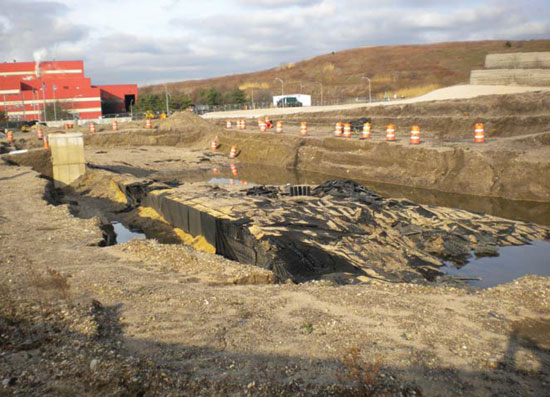Green Building: Essential Design Strategies for a Sustainable Future
Water Management Options
Through federal rulemaking (Phase I in 1990, Phase II in 2003 and Phase III currently ongoing), the NPDES permit program has expanded significantly since it was originally established and today, most development projects in urban and suburban areas are required by federal, state and/or local regulations to provide treatment of stormwater runoff though the use of best management practices (BMPs).
Above-Ground BMPs
Above-ground BMPs include stormwater treatment practices such as swales, extended detention and retention ponds, and bioretention facilities.
Swales refer to the use of land or other landscaped feature to collect and convey water runoff. Swales range from very simple open-chanel depressions in the soil that follow the contour of the land, to very complex engineered bioswales designed specifically to attenuate and treat stormwater runoff.
 |
Failed plastic stormwater module system at a landfill in Long Island, N.Y. Photo courtesy of A. L. Filshill |
Ponds. A stormwater management pond refers to an excavated area that is typically constructed to collect and treat stormwater runoff. The most common types of ponds are retention and detention.
 |
Corrugated pipe culvert collapse Photo courtesy of Newnham Farms |
Retention ponds, also called “wet ponds” or “retention basins,” are permanent pools of standing water designed to hold stormwater runoff for long periods of time and treat the water primarily through sedimentation, biological uptake, and chemical and biological processes that occur between events in the permanent pool.
Detention ponds, typically referred to as “dry extended detention basins” or simply “dry ponds” when used for water quality purposes, are designed to temporarily detain stormwater runoff and promote the settlement of pollutants. Typically dry ponds are designed to fully empty in a time ranging from 12 to 24 hours depending on the characteristics of stormwater solids (smaller particles require longer detention times for removal). Unlike retention ponds, which always have some water present, detention ponds are designed to empty between rain events.
Bioretention ponds, also called “rain gardens” or “bioretention filters or cells,” are designed and engineered to capture, temporarily store and remove pollutants from stormwater runoff. A bioretention facility provides temporary storage of runoff on the surface of the facility (sized similarly to wet or dry ponds); however, bioretention facilities are designed to infiltrate the captured water, providing filtration in the process. The depth of ponding in a bioretention facility is typically far less than in a wet or dry pond. Bioretention gardens are often designed with underdrains if subsoils or presence of other nearby infrastructure make infiltration difficult or undesirable. Bioretention facilities also include vegetative components that aid in evapotranspiration and nutrient cycling.
Below-Ground BMPs
Below-ground BMPs typically employ pollutant removal processes including sedimentation, filtration, straining and other forms of treatment incorporated into underground vault, pipe and manhole systems. Underground systems can be designed to include many of the same processes as surface systems including straining, sedimentation, filtration and others; although, biological processes are generally absent or less significant due to the fact the facilities are underground and do not receive sunlight. Extended detention and sand or media filtration are common processes used by subsurface BMPs. Primary below-ground solutions include metal systems using corrugated metal pipes, plastic systems such as chambers, arches and corrugated pipe, and concrete systems such as vaults, culverts, chambers or pipes.
Metal solutions. Corrugated metal pipes come in a wide variety of sizes with multiple end fittings and are designed for relatively fast installation in a variety of configuration layouts and project applications.
Plastic solutions. Plastic chambers, arches and corrugated pipe solutions are made from lightweight HDPE plastic material and are also available in a wide variety of sizes designed for easy handling as well as fast installation in a variety of configurations. Plastic solutions can range from small low-profile pipe systems to larger-capacity plastic chamber systems.
Concrete solutions offer exceptional strength and durability, and can be designed and engineered to meet a wide range of project needs. From standard reinforced concrete pipe (RCP) to high-challenge projects requiring extensive planning and engineering, the versatility and strength of engineered concrete make it the most durable material of choice for stormwater management systems whether poured-in-place or precast.
Poured-in-place concrete offers increased jobsite flexibility with forming that can be designed, changed or customized on the jobsite as needed to create unique stormwater management solutions.
Precast concrete solutions for managing stormwater include prefabricated engineered vaults, chambers and pipe products that can be manufactured in a variety of shapes and sizes and can be assembled into systems having a multitude of configurations. Modular sized vaults allow for rapid installation of multiple vaults into a complete system. The durability and strength of precast concrete also make it ideal for use beneath areas requiring traffic loading.
In addition to managing the quantity of stormwater runoff, concrete solutions for improving the quality of the stormwater can also be incorporated into the system. Treatment options, such as pre-treatment vaults, integrated treatment and post-treatment vaults, can vastly improve the quality of captured stormwater.









